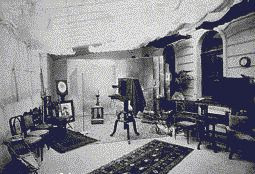
1.) PHOTOGRAPHIC LIGHTING3.11 - PHOTO and PHOTOGRAPHIC LIGHTING
Lighting for still photography is just as much of an art form as is stage lighting design. Generally however, there is no such thing as a 'photographic' lighting designer. Photographers usually do their own lighting and as such, they are responsible for all artistic elements of the image, including; light, contrast, balance, composition, style, impression, mood, etc.
The professional photographer must know the properties of his film in respect to proper exposure, saturation and contrast. Although the human eye can adjust to a wide range of 'brightness' all at once in the visual field, the camera and film cannot. Contrast must be limited to perhaps no more than 3:1 for some films.
Sometimes the stage lighting designer will be present during a production to work with a still photographer, taking documentary or public relations shots of a production. The designer can assist the photographer by ensuring that there is interesting light where needed. Also, background scenery and cycloramas that appear adequately illuminated to the eye, may appear dark, dingy and underexposed to the film. Add additional lighting to these elements as required to reduce subject to background contrast.
Typically theatre photographers will use a 'high speed', Black and white or color film. Positive transparencies (slides) are still preferred by most professional photographers, over a color print film, due to their higher color saturation and due to the fact that they 'reproduce' better than do prints, for most applications.
2.) PHOTOGRAPHIC LIGHTING - TECHNIQUES
Natural light and studio lighting are both commonly used for photographic lighting applications. Good studio lighting is often loosely based on the principals of McCandless. Two lights are placed at 45 degrees to each other, in front of the subject. Often one light is brighter (KEY LIGHT) and is used to provide a sense of direction and motivation. The other light (FILL LIGHT), is of slightly lower intensity and 'softer', and is used to fill in shadows caused by the main light. Often 'back' lighting to the subject to provided to help isolate the subject from the background. Additional lighting is then provided to the background as needed.
There are many photographic lighting techniques shown in many photography books. One of my favorite techniques however, is as follows: To photograph a very large room, (church, auditorium, etc.) with poor lighting do the following: Select a film speed and exposure that will allow a 3-5 minute exposure. Then, open the lens and walk throughout the room with a 1000 watt flood light, evenly painting all surfaces. All surfaces in the photo will be properly exposed, and the 'light painter' will be invisible if he moves quickly enough. Simply paint more light where darker surfaces or additional detail is required. Some experimentation with this process is required.
No comments:
Post a Comment